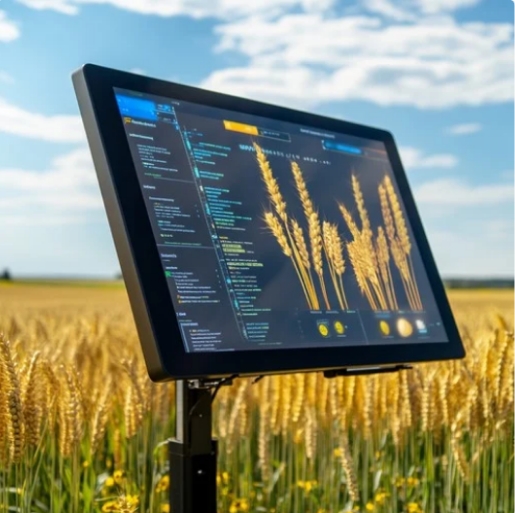An Embedded HMI (Human-Machine Interface) Display Solution is a technology that provides a user interface for interaction with machines, devices, or systems, typically in industrial or smart environments. The term "embedded" refers to the fact that the HMI is integrated directly into the device or system, rather than being a separate, standalone unit. It typically combines hardware (like a touchscreen display) and software (for user interface and functionality) in a single package.

Key Features of Embedded HMI Display Solutions:
1. Touchscreen Interface
· Interactive Controls: The primary feature of an embedded HMI is its touchscreen interface that allows users to interact directly with the system, adjusting settings, controlling functions, or monitoring data.
· Variety of Touch Types: Depending on the application, you might see resistive (pressure-sensitive) or capacitive (finger or stylus touch) touchscreens.
2. Embedded Hardware
· Compact Integration: The display is often embedded directly into the machine, device, or control panel. This makes it part of the equipment rather than an external controller.
· Low Power Consumption: Many embedded HMIs are designed to consume minimal power, especially for battery-powered devices or systems requiring energy efficiency.
· Rugged Design: Embedded HMI solutions are typically built to endure harsh environments, with features like IP-rated enclosures (waterproof, dustproof), high durability, and resistance to temperature extremes.
3. Customizable User Interface (UI)
· Graphical User Interface (GUI): The software provides an intuitive graphical interface for operators to monitor system status, input commands, and receive feedback in real time.
· Customizable Screens: The interface can be tailored to show various types of data, such as graphs, gauges, alarms, and buttons to control different parameters of the system.
· Multiple Screen Layouts: Users can switch between different views or pages (e.g., overview, detailed status, settings, and maintenance) depending on the complexity of the system.
4. Communication with Embedded Systems
· Protocols Support: Embedded HMIs often support various industrial communication protocols, such as Modbus, CAN, Ethernet/IP, OPC, etc., allowing them to interface with other devices, sensors, or control systems.
· Real-Time Data Display: The system can display real-time data, such as temperature, pressure, motor speeds, or energy consumption, directly from embedded sensors or devices.
5. Data Logging and Visualization
· Historical Data: Embedded HMIs can store historical data, such as operation logs, system performance records, and fault history, and present it in an easy-to-read format (e.g., charts, graphs).
· Trend Analysis: For advanced systems, the HMI might provide trend analysis features to help operators detect anomalies or optimize processes based on historical data.
6. Alarm and Event Management
· Alerts and Notifications: Embedded HMIs can be configured to display alarms, warnings, or critical events in real time, alerting operators of system malfunctions, thresholds being exceeded, or required maintenance.
· User Feedback: They often include visual or audible feedback for acknowledging or silencing alarms, as well as tools for diagnostics.
7. Multi-Functionality
· Control and Monitoring: Embedded HMIs not only serve as a display to monitor system parameters but also allow users to modify settings, perform diagnostics, and execute commands, all from a single interface.
· Multi-Device Connectivity: Advanced systems may enable the HMI to connect to and control multiple devices or systems simultaneously, making it suitable for complex operations or IoT environments.
8. Security Features
· Access Control: These systems often have security features like password protection or user role management to restrict access to certain functions based on user authorization levels.
· Data Encryption: For systems dealing with sensitive data, embedded HMIs may support encryption protocols to ensure secure data transfer and communication.
Applications of Embedded HMI Display Solutions:
1. Industrial Automation: Embedded HMIs are widely used in factory automation systems, machinery control, PLC (Programmable Logic Controller) interfaces, and SCADA (Supervisory Control and Data Acquisition) systems.
2. Building Management Systems (BMS): For smart buildings, embedded HMIs can be used to manage HVAC, lighting, security, and other subsystems from a centralized interface.
3. Consumer Electronics: Devices like home appliances, vending machines, and car dashboards often integrate embedded HMIs for user control and feedback.
4. Healthcare Devices: Embedded HMIs are common in medical equipment, where operators need to interact with diagnostic devices, monitors, or infusion pumps.
5. Energy and Utilities: For managing power grids, water treatment plants, or renewable energy systems, embedded HMIs display real-time data and allow for control adjustments.
6. Transportation: Used in vehicles, embedded HMIs control infotainment systems, navigation, climate control, and more.
Benefits of Embedded HMI Display Solutions:
1. Compact and Space-Saving: Being embedded into devices or systems, these HMIs save space and eliminate the need for external control panels.
2. Improved User Experience: The intuitive touchscreen interface makes it easier for operators to interact with and manage complex systems, improving overall operational efficiency.
3. Reduced Costs: By integrating the display and control interface directly into the device, you avoid the need for additional equipment and infrastructure.
4. Reliability: Embedded solutions are often built to withstand harsh conditions, including exposure to dust, moisture, or temperature extremes, ensuring long-term performance without failures.
5. Real-Time Interaction: The direct, real-time feedback from embedded HMIs allows for faster decision-making and immediate adjustments to system settings.
Challenges of Embedded HMI Display Solutions:
1. Customization Complexity: Customizing the interface and functionality for specific applications can require specialized knowledge, particularly when integrating with complex systems.
2. Software Development: Developing the software that drives the HMI display can be time-consuming and requires expertise in embedded systems and user interface design.
3. Maintenance: Over time, embedded systems might need updates or repairs. Since the display is part of the embedded system, replacing or upgrading components can be more challenging than with standalone HMI solutions.
4. Cost: While they can reduce operational costs, developing and integrating an embedded HMI solution can be costly initially, especially for complex systems or highly customized displays.
Embedded HMI (Human-Machine Interface) display solutions are widely used across various industries due to their ability to provide intuitive user interfaces for interacting with machines, systems, and processes.
1. Industrial Automation
Machine Control
SCADA Systems.
PLC Integration
2. Building Management Systems (BMS)
HVAC Control
Lighting Control
Energy Monitoring
Security Systems
3. Healthcare and Medical Devices
Patient Monitoring
Diagnostic Equipment
Surgical Instruments
4. Consumer Electronics
Home Appliances
Smart Thermostats
Vending Machines
5. Automotive and Transportation
Vehicle Dashboards
Electric Vehicle (EV) Charging Stations
Public Transport
6. Energy and Utilities
Power Grid Monitoring
Water Treatment Plants
Renewable Energy Systems
7. Retail and Point-of-Sale (POS) Systems
Self-Checkout Kiosks
Digital Signage
8. Agriculture and Farming
Automated Irrigation Systems
Farm Machinery
Greenhouse Monitoring
9. Military and Defense
Weapon Control Systems
Surveillance Systems
Training Simulators
10. Aerospace
Cockpit Displays
Ground Support Equipment

Benefits of Embedded HMI Display Solutions:
· Space Efficiency: The integration of display and control interface within the equipment saves space, making it ideal for compact or specialized systems.
· Durability: Many embedded HMIs are built to endure harsh conditions (extreme temperatures, vibrations, moisture) and are more rugged than typical desktop or mobile devices.
· Real-Time Monitoring: These systems provide live feedback, allowing for immediate action or adjustments, which is critical in many industrial and safety-critical applications.
· Cost Efficiency: By embedding the HMI directly into the system, you eliminate the need for separate control units, which can reduce overall costs.